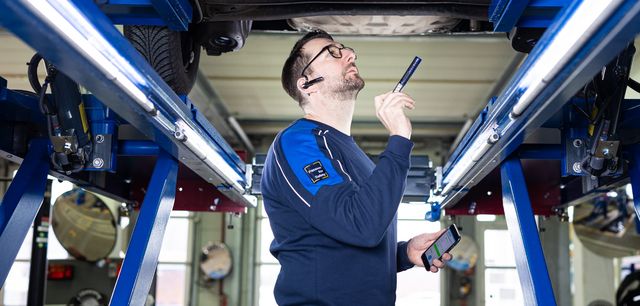23 May 2024
“Alexa, turn on the light”, “Siri, call Auntie Kate”: AI-supported voice control systems have become an indispensable part of many people’s everyday lives. In the future, they are also going to be used in vehicle testing: Roman Meier-Andrae and his colleagues at TÜV NORD Mobility, in collaboration with the voize start-up, have developed an AI tool that supports experts as they carry out periodic vehicle inspections.
Mr. Meier-Andrae, you’ve co-developed a digital inspection assistant that is intended to facilitate the work of testers in periodic vehicle inspections. How did you do that?
Roman Meier-Andrae: At the moment, whenever testers are standing under a car and find a defect, they have to pause the inspection and go through the cumbersome process of finding and unlocking their tablet and logging the defect. In doing so, they have to assign it to a catalogue of defects that has 45,000 entries. This takes time and, of course, keeps taking them away from the actual testing situation. With the digital test assistant, the experts can easily document defects via a headset using voice input. The system then automatically assigns them to a specific defect in the overall catalogue. If it is unsure, it offers different options through a smartphone-based user interface – and is constantly learning. Users do not have to learn specific commands for this, but can simply start talking. The system can cope with dialects and is not thrown by loud noises, which are the order of the day in a car repair workshop.
And what advantages does the use of AI offer vehicle owners?
It supports the testers so that they can concentrate fully on their actual task, which is to take a thorough look at the vehicle. But it also gives them some extra time, for example, to respond to possible questions from vehicle owners and to coordinate any repairs that may be needed with the workshop managers. At the same time, they can offer more detailed test reports which give owners a more comprehensive picture of the safety condition of their car – in other words, they can draw attention especially to minor defects that should be kept an eye on. This saves money and is less hard on the nerves, as it allows owners to get their vehicles serviced or repaired earlier and in a more precisely targeted manner.
Give us an insight into the development of the app. How did you go about it?
We started with a study in which we took a very close look at the everyday life of the testers. We then came across the Berlin-based start-up, which had developed a voice control system for nursing care documentation and follows a similarly practice-oriented and user-centric approach. To do this, they first spent a few weeks at a care home and looked at how the nurses documented what they needed and where the issues were, all the while operating under chronic time pressure. Transferring this system to meet our requirements was not a foregone conclusion, but since the start-up has a few gifted AI experts on board and works incredibly fast, we’re now already at version number 90. We’re successively improving the system, integrating new functionalities in close coordination with our 100 test users and getting feedback from them. Seasoned older colleagues tell us that the tool makes their everyday work noticeably easier. This is the greatest success we could have hoped for as well as being an incentive to take the work further.
About Roman Meier-Andrae:
Roman Meier-Andrae is Director of IT and Digitalisation at TÜV NORD Mobilität.
Why didn’t you just use a voice control system from one of the big tech companies?
The voice assistants everyone knows, from Alexa to Siri, are designed for extremely generic requests: In principle, anyone can ask anything, and the system must be able to interpret the context correctly. The word “fit” might just as easily describe a seizure as the way an item of clothing sits on the body. This constantly pushes these systems to their limits. We – our team from TÜV NORD Mobilität and the experts from voize – have the advantage of knowing the context in which a term is expressed and the dictionary to which it refers – although, as we saw earlier, it’s also very large, with some 45,000 defects. This means that we can narrow down the field of possible meanings more precisely and essentially need to develop a semantic network that covers all conceivable designations, for example for the car seat or the indicators. Our hit rate is now 99.8 percent. This would be virtually unachievable with the large generic systems.
How might the use of AI in these or other test situations evolve in the future?
With partially automated driving, more and more sensors are crowding into vehicles. This is also making testing harder and more protracted. To counter this, experts will be able to use more and more data from a cloud, taken for example from a digital twin of the vehicle concerned. A recommendation system based on the data collected and the experiences that other testers have had with a particular model of car is also conceivable. A sample recommendation might be: “With this type of vehicle, we often find problems with the front left suspension, so take a closer look”. Overall, AI is increasingly going to evolve into a second-in-command for tests, providing optimal support with annoying tasks or those in which it is easy to make mistakes. Without causing additional work in the process, as is still all too often the case with the digital technology of today.




